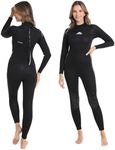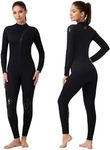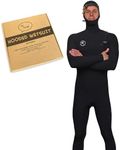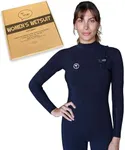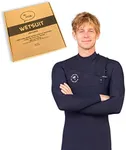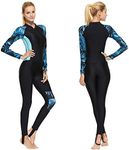Buying Guide for the Best Women S Wetsuits
Choosing the right women's wetsuit is essential for comfort, performance, and safety in the water. Whether you're surfing, diving, or engaging in any water sport, a well-fitted wetsuit can make a significant difference. The key is to understand the various specifications and how they align with your needs and preferences. Here are the key specs to consider when selecting a women's wetsuit.ThicknessThickness refers to the material's thickness in millimeters, typically shown as two numbers (e.g., 3/2mm). The first number represents the thickness of the torso area, and the second number represents the thickness of the limbs. Thicker wetsuits (5/4mm or 6/5mm) provide more insulation and are suitable for colder waters, while thinner wetsuits (2/1mm or 3/2mm) are better for warmer conditions. Choose the thickness based on the water temperature you'll be in: thicker for cold water and thinner for warm water.
MaterialWetsuits are usually made from neoprene, a synthetic rubber that provides insulation and flexibility. The quality of neoprene can vary, with higher-end wetsuits offering more stretch and comfort. Some wetsuits also incorporate other materials for added flexibility or durability. If you need more freedom of movement, look for wetsuits with high-stretch neoprene. For durability, consider those with reinforced areas.
SeamsThe construction of the seams affects both the durability and the warmth of the wetsuit. Flatlock stitching is common in thinner wetsuits and is suitable for warmer waters, but it can let water in. Blindstitched and glued seams are better for colder conditions as they are more watertight. Taped seams offer the highest level of waterproofing and durability. Choose the seam type based on the water temperature and your activity level.
FitA proper fit is crucial for a wetsuit to function effectively. It should be snug but not too tight, allowing for a full range of motion without letting water in. Women's wetsuits are designed to accommodate different body shapes, so it's important to try on different brands and sizes to find the best fit. Pay attention to the fit around the shoulders, chest, and hips, as these areas are critical for comfort and performance.
Entry SystemThe entry system refers to how you get in and out of the wetsuit. Back-zip wetsuits are easier to put on and take off but may allow more water to enter. Chest-zip wetsuits offer better water sealing and flexibility but can be trickier to get into. There are also zip-free options that provide maximum flexibility and minimal water entry but can be the most challenging to put on. Choose an entry system based on your flexibility, comfort, and the level of water sealing you need.
Style and DesignWhile functionality is key, the style and design of a wetsuit can also be important for personal preference and confidence. Women's wetsuits come in various colors, patterns, and cuts. Some may have additional features like reinforced knees or extra padding. Choose a style that you feel comfortable and confident in, as this can enhance your overall experience in the water.

